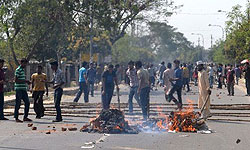Workers Protest in Dhaka over Factory Deaths


Thousands of garment factory workers protested in the capital, Dhaka, over the death of more than 150 workers in building collapse, as rescuers continued to hunt for survivors, local media reported.
Al Jazeera’s special correspondent said on Thursday that thousands of protestors took to the streets of Dhaka with sticks in their hands chanting slogans such as “we want execution of the garment factory owners.”
The Bangladesh Garment Manufacturers and Exporters Association building office has been attacked, the correspondent said.
Workers have blocked road and indulged in vandalism at some places, the Daily Star newspaper reported.
The protests come a day after a garment factory collapsed killing at least 161 and there are fears the death toll might go up, even as criticism mounted of foreign firms that source cheap clothes from the country.
After visiting the disaster site, Muhiuddin Khan Alamgir, interior minister, told reporters the building had violated construction codes and that “the culprits would be punished”.
More than 1,000 people were injured when the site housing five garment factories on the outskirts of Dhaka imploded on Wednesday, allegedly after managers ignored workers’ warnings that the building had become unstable.
Flags flew at half-mast on Thursday as the shell-shocked country declared a day of mourning for the victims of the nation’s worst factory disaster, which highlighted a new safety concerns in Bangladesh’s vital garment industry.
Army Brigadier General Mohammed Siddiqul Alam Shikder said many people are still trapped in the building, which housed a number of garment factories employing hundreds of people.
Workers had warned a day earlier that large cracks had developed in the structure.
A clearer picture of the rescue operation would be available by afternoon, Shikder said.
Searchers worked through the night to get through the jumbled mess of concrete with drills or their bare hands, passing water and flashlights to those pinned inside the building.
“I gave them whistles, water, torchlights. I heard them cry. We can’t leave them behind this way,” said fire official Abul Khayer.
Local police chief Mohammaed Asaduzzaman said police and the government’s Capital Development Authority had filed separate cases of negligence against the building owner.
Searchers cut holes in the jumbled mess of concrete, passing water and torches to those pinned inside the building as rescue operations illuminated by floodlights continued through the night.
The disaster came less than five months after a factory fire killed 112 people and underscored the unsafe conditions in Bangladesh’s booming garment industry, the second biggest in the world.
Workers said they had hesitated to go to into the building on Wednesday morning because it had developed such large cracks a day earlier that it even drew the attention of local news channels.
Abdur Rahim, who worked on the fifth floor, said a factory manager gave assurances that there was no problem, so employees went inside.
“After about an hour or so, the building collapsed suddenly,” Rahim said. He next remembered regaining consciousness outside.
Only the ground floor of the Rana Plaza in the Savar district remained intact after the collapse.
Fire crews said up to 2,000 people were in the building when it fell.
Building collapses are common in Bangladesh. Many multi-story blocks are built in violation of construction standards.
In 2005, dozens were killed after a multi-story garment factory collapsed in the same area.







